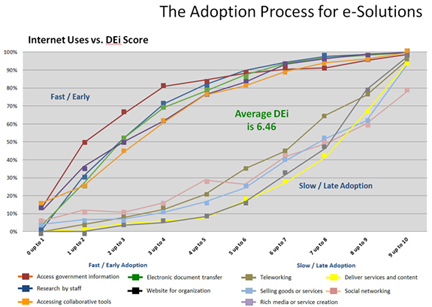Change is Hard… and So is Utilization
by Michael Curri & Doug Adams
In work across four American States, SNG research has found that not all e-solutions are created equally. Some are relatively easy to drive adoption and utilization… some are extremely different and require overcoming great challenges. When we plot out the utilization of various e-solutions versus SNG’s proprietary Digital Economy index (DEi) which measures the utilization of broadband as a platform for innovation, we see just how hard in what we’ve dubbed our “football chart” below. As a reminder, DEi scores range from 1 to 10 (10 being highest), with higher scores reflecting the greater the number, scope and sophistication of the Internet activities deployed in an organization.

As we discussed last month – businesses with a high DEi, meaning higher levels of adopting and using e-solutions, experience larger percentage increases of revenues (between 27 and 31%). Increasing Internet utilization dramatically increases business revenues and job creation.
So what does this have to do with the football chart? Let’s dig deeper and look at what separates the more successful organizations in utilizing broadband, creating efficiencies and growing revenues. It’s not the easy, “quick to adopt” solutions that include accessing government information online, sharing files, using collaborative tools, online research, and companies hosting their own website. These are all basic and even unsophisticated businesses are doing these.
But what separates the mediocre from the great… who is “winning” according to SNG’s research and the ‘football chart?’ The organizations that take on the difficult challenges, the more complicated e-solutions, are the businesses that are utilizing broadband to grow their business. These include:
- Teleworking – Using the Internet as your “virtual office,” enabling a geographically disparate workforce.
- Rich media – Creating multimedia content and interactive tools to market products/services and increase sales opportunities
- Social networking – Using today’s social network forums to promote business and collaborate with peer groups and colleagues
- eCommerce – Selling goods or services online – this can include driving leads toward payment and does not require online payment.
- Deliver services or content online – From customer service departments to digitized products.
Are you focusing on simply providing broadband and waiting for people to adopt… and ultimately utilize e-solutions (the tried and failed build it and they will come mentality) or are you driving utilization? Focus on driving sophisticated use of broadband and you’ll see your region’s economy reap the benefits. SNG has helped to look at where gaps are and prescribe next steps for economic development through broadband in communities and regions.




